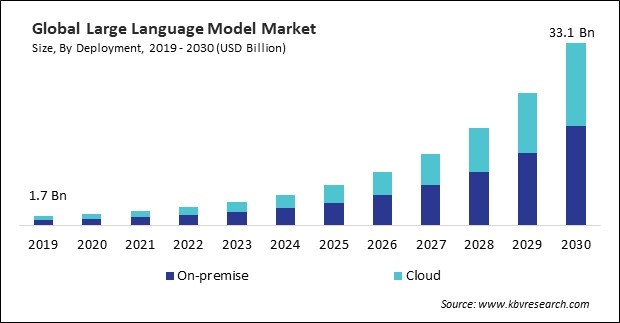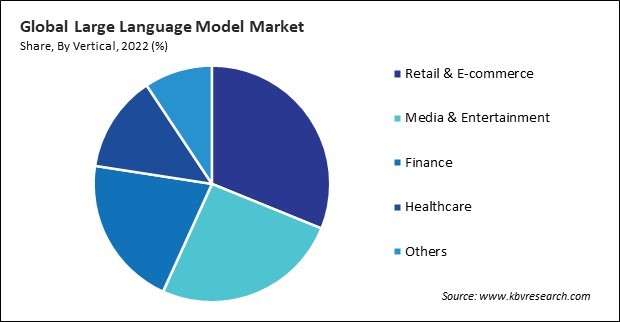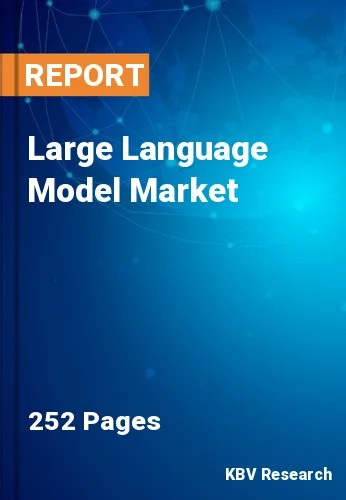“Global Large Language Model Market to reach a market value of USD 33.1 Billion by 2030 growing at a CAGR of 34.3%”
The Global Large Language Model Market size is expected to reach $33.1 billion by 2030, rising at a market growth of 34.3% CAGR during the forecast period.
Businesses across various sectors are increasingly deploying chatbots and virtual assistants to automate customer service interactions. Thus, the chatbots and virtual assistant segment acquired $1,045.4 million in 2022. These AI-driven systems can handle routine queries, provide information, and guide users through processes, freeing up human agents for more complex tasks. Thus, these aspects will boost the demand in the segment.

Prominent language models, boosted by deep learning methodologies, have exhibited an exceptional capacity to comprehend and produce text that closely resembles that of humans. Their extensive training on diverse datasets enables them to grasp nuances, context, and subtleties in language, allowing for more sophisticated language understanding. In addition, large language models are a fundamental component of chatbots and virtual assistants. These applications benefit from the models' capacity to comprehend user input, generate contextually relevant responses, and provide more interactive and human-like conversations. As businesses increasingly adopt chatbots for customer support, information retrieval, and engagement, the demand for advanced language models grows. Additionally, it can generate content quickly and efficiently. This is particularly beneficial for businesses looking to produce a large volume of content within a short time frame, such as articles, blog posts, or marketing materials. Businesses can leverage large language models to scale up their content creation efforts. These models can consistently produce content with a similar tone, style, and quality, maintaining a cohesive brand identity across various pieces of content. This adaptability ensures the generated content aligns with different industries' specific requirements and conventions. Hence, these aspects will lead to enhanced growth in the market.
However, there is a risk of unintended information leakage during the training of large language models. The models may inadvertently memorize or overfit sensitive information present in the training data, leading to potential privacy breaches. Trained models might retain traces of the input data in their weights, and there's a possibility of extracting sensitive details from these weights, raising privacy concerns. During the inference phase, when models process user queries or inputs, there's a risk of unintentionally disclosing sensitive information if the models are not designed to handle such data securely. Techniques like differential privacy aim to protect individual data points by injecting controlled noise into the training process, helping to prevent the memorization of specific examples. Thus, these factors will reduce growth in the market.
Based on deployment, the market is divided into cloud and on-premise. The on-premise segment recorded the maximum revenue share in the market in 2022. Sectors that handle confidential data, including healthcare, finance, and legal, frequently give precedence to on-premises solutions to maintain direct oversight of their information. On-premises deployment ensures that sensitive language data remains within the organization's infrastructure, addressing data security and privacy compliance concerns. Therefore, these factors will assist in the growth of the segment.
On the basis of vertical, the market is divided into healthcare, finance, retail & e-commerce, media & entertainment, and others. In 2022, the media and entertainment segment witnessed a substantial revenue share in the market. It facilitate translation on a broader scale, enabling media and entertainment content to reach global audiences. This is especially valuable for streaming platforms, news outlets, and content providers seeking to expand their reach and cater to diverse linguistic demographics. Thus, these factors will help expand the segment.

Based on application, the market is segmented into customer service, content generation, sentiment analysis, code generation, chatbots & virtual assistant, and language translation. The content generation segment procured a promising growth rate in the market in 2022. The demand for content spans multiple industries, including marketing, advertising, e-commerce, journalism, and more. Large language models offer versatility in generating content for different purposes, making them valuable across various applications. Owing to these aspects, the segment will witness enhanced growth in the coming years.
Free Valuable Insights: Global Large Language Model Market size to reach USD 33.1 Billion by 2030
By region, the market is segmented into North America, Europe, Asia Pacific, and LAMEA. The North America segment procured the highest revenue share in the market in 2022. The region is a hub for cutting-edge research and development in AI and natural language processing. Advances in large language models, including innovations in model architectures, training techniques, and applications, often originate from research institutions and companies in North America. Hence, these factors will lead to enhanced growth in the segment.
| Report Attribute | Details |
|---|---|
| Market size value in 2022 | USD 3.2 Billion |
| Market size forecast in 2030 | USD 33.1 Billion |
| Base Year | 2022 |
| Historical Period | 2019 to 2021 |
| Forecast Period | 2023 to 2030 |
| Revenue Growth Rate | CAGR of 34.3% from 2023 to 2030 |
| Number of Pages | 252 |
| Number of Tables | 390 |
| Report coverage | Market Trends, Revenue Estimation and Forecast, Segmentation Analysis, Regional and Country Breakdown, Porter’s 5 Forces Analysis, Company Profiling, Companies Strategic Developments, SWOT Analysis, Winning Imperatives |
| Segments covered | Deployment, Application, Vertical, Region |
| Country scope |
|
| Companies Included | Amazon Web Services, Inc. (Amazon.com, Inc.), Baidu, Inc., Google LLC (Alphabet Inc.), Huawei Technologies Co., Ltd. (Huawei Investment & Holding Co., Ltd.), Meta Platforms, Inc., Microsoft Corporation, OpenAI, LLC, Yandex N.V., IBM Corporation, NVIDIA Corporation |
By Deployment
By Vertical
By Application
By Geography
This Market size is expected to reach $33.1 billion by 2030.
Growing advancements in natural language processing are driving the Market in coming years, however, Concerns about data privacy and security concerns restraints the growth of the Market.
Amazon Web Services, Inc. (Amazon.com, Inc.), Baidu, Inc., Google LLC (Alphabet Inc.), Huawei Technologies Co., Ltd. (Huawei Investment & Holding Co., Ltd.), Meta Platforms, Inc., Microsoft Corporation, OpenAI, LLC, Yandex N.V., IBM Corporation, NVIDIA Corporation
The expected CAGR of this Market is 34.3% from 2023 to 2030.
The Retail & E-commerce segment is leading the Market by Vertical in 2022; there by, achieving a market value of $9.7 billion by 2030.
The North America region dominated the Market by Region in 2022, and would continue to be a dominant market till 2030; there by, achieving a market value of $11.6 billion by 2030.
Our team of dedicated experts can provide you with attractive expansion opportunities for your business.

 Drivers
Drivers
 Restraints
Restraints
 Opportunities
Opportunities
 Challenges
Challenges
